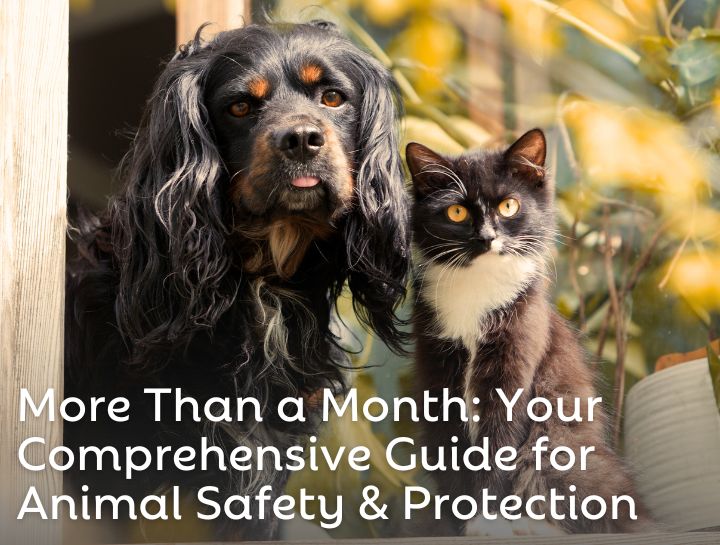Your Comprehensive Guide for Animal Safety and Protection

October is National Animal Safety and Protection Month, a time dedicated to raising awareness about the importance of keeping our beloved animal companions safe and healthy. While we all strive to provide the best care for our pets every day, this month serves as a perfect opportunity to review and reinforce your safety measures. From routine health checkups to emergency preparedness, explore the essential steps you can take to ensure your pets live a long, happy, and secure life.
The Foundation of Pet Wellness: Health and Identification
A healthy pet is a safe pet.
Yearly Checkups: Regular yearly vet checkups are crucial for preventative care. These appointments allow your veterinarian to catch potential issues early, from minor sicknesses to dental problems and more serious diseases. During these visits, you can also discuss any concerns you may have regarding topics such as allergies, diet, and any abnormal behaviors you’ve observed in your pet.
ID Tags & Microchipping: A simple collar with an ID tag is a good start, but microchipping provides a permanent form of identification. If your pet ever gets lost, a microchip can be scanned at a vet's office or shelter, greatly increasing the chances of a happy reunion.
Healthy Diet: Be vigilant about what your pet eats. Many human foods are toxic to animals, including chocolate, grapes, raisins, onions, garlic, and xylitol (a common artificial sweetener). Always keep these items out of reach. In addition to food, pay attention to your pet's water intake to avoid dehydration.
Creating a Safe Haven: Pet-Proof Your Home
Your home is your pet's sanctuary, but many everyday items can pose a hidden danger.
Toxic Plants: Be mindful of common household plants. Many are toxic to pets, including lilies, sago palms, and tulips. Do your research before bringing a new plant home and choose pet-safe alternatives, as appropriate.
Safe Toys: When it comes to playtime, choose safe toys for your dogs and cats. Avoid toys with small parts that can be chewed off and swallowed or toys that can come unraveled, like string toys. Opt for durable, size-appropriate toys instead.
Secure Doors and Windows: Make sure all your windows have sturdy screens free of tears or holes. Always check that doors are fully closed and latched behind you. Consider using childproof locks or latches on doors and cabinets to prevent curious pets from getting into hazardous items or escaping outdoors.
Planning for the Unpredictable: Emergency Preparedness and First Aid
Life is full of unexpected twists, and preparing for emergencies can make all the difference. Create an emergency preparedness kit for your pet, including food, water, medications, a first-aid kit, and copies of their medical records. Know where the nearest 24-hour emergency hospital is and have their number saved in your phone. Learn basic first aid for pets, such as how to address minor cuts or what to do in case of choking. A little knowledge can go a long way in a crisis.
Away from Home: Pet Sitters and Avoiding Separation Anxiety
When you can't take pets with you, keeping them safe at home is critical.
Kennels: For some pet owners, using a kennel or boarding facility is the right choice. A professional boarding kennel provides a secure environment with trained staff. On the other hand, kenneling at home can be an excellent way to keep your pet safe and prevent destructive behavior. If properly trained, a crate becomes a secure den, offering a safe space for your pet to relax in your absence. Make sure the crate is a positive place and always ensure your pet has had plenty of exercise before being crated.
Pet Sitters: Choose someone with good references and a solid understanding of animal behavior. Provide them with a schedule and instructions to keep your pet engaged and happy, reducing boredom and anxiety that can lead to destructive habits.
Free Roam: This option is best for well-behaved, non-anxious pets that are accustomed to being left alone. A fully pet-proofed home is necessary—meaning all toxic plants, small items, and dangerous substances are out of reach. To prevent boredom and anxiety, leave out puzzle toys filled with treats, and consider turning on a radio or television for background noise. Many pet owners also find it helpful to set up a pet camera to check in on their furry friend and ensure everything is going smoothly. Free roaming provides your pet with the most freedom but also requires the most preparation to ensure their safety.
National Animal Safety and Protection Month reminds us that being a responsible pet owner is a continuous commitment. By proactively addressing potential dangers, preparing for emergencies, and prioritizing their health and well-being, we can ensure our pets live a life full of love, happiness, and, most importantly, safety. If you have any concerns about your pet’s health, please don’t hesitate to contact us at (845) 278-8000.
